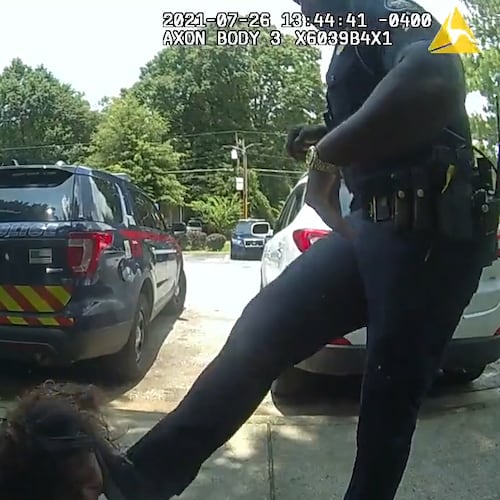Driving on the left side of the road will soon be legal in Georgia.
That, and driving in between oncoming lanes of traffic.
And though some drivers already excel at this, how about driving through an intersection without waiting for a light or stop sign?
With limited funding and new blood prompting new thinking at the state Department of Transportation, those are all parts of new intersection designs -- counterintuitive, a hard sell on paper -- that could help turn around Atlanta's traffic,
Some have never been tried in Georgia and have barely been seen in the United States, but they will be on metro Atlanta streets soon. And engineers swear that as wacky as they may look, the new intersections will make perfect sense once drivers are using them.
More to the point, they should ease congestion for a relative pittance, supporters say.
"It's necessity, the mother of invention," said David Spear, a spokesman for the state DOT. "We don't have the money or the time to keep doing things like we did decades ago."
So prepare to get acquainted: The diverging diamond. The continuous flow intersection. And you may already have met the roundabout, a European standby but a relative newcomer to Georgia.
The diverging diamond
Starting in the spring, the state DOT plans to rebuild Ashford-Dunwoody Road over I-285 in a way that has never been done in Georgia, and was only introduced in the United States last year, in Missouri.
The diverging diamond design will make traffic in both directions cross over to the left side of the road as it approaches the bridge over the interstate. After the bridge, it crosses back to the right. So on the bridge and just after, at the time when a lot of drivers want to turn left, they will already be in the best possible place to do that, the far left lane.
Local business and government officials are also pitching diverging diamonds for interchanges on I-85 at Jimmy Carter Boulevard and Pleasant Hill Road in Gwinnett County, and Wade Green Road over I-75 in Cobb County.
“I think we need this innovative look at how we resolve the timing of traffic and delay, because we can’t tear down every interchange,” said Yvonne Williams, president of the Perimeter Community Improvement Districts, which spearheaded the I-285 project.
If there was funding she might prefer a giant new bridge with more lanes, Williams said, but “it just hasn’t been moving and I didn’t see the construction money coming forward anytime in the near future.”
Is she confident it will work?
“I am very, very optimistic,” she said.
One thing’s for sure: At about $8 million, the diverging diamond will cost a fraction of a major bridge rebuild, which could ring up at $100 million or more.
Roundabouts
These are old hat in Europe, but DOT has rarely supported them here until recently. Now DOT is joining local governments to build dozens of roundabouts.
“It's just thinking a little bit more out of the box, to solve our transportation problems with a more efficient and cheaper method,” said Gerald Ross, DOT’s chief engineer. After Ross became chief engineer in 2007, DOT changed its policy to encourage, and then require, consideration of roundabouts for new intersections.
Spear, the DOT spokesman, confirmed that some previous chief engineers weren’t so big on roundabouts, and that Ross made a key difference, but Ross would not comment.
Roundabouts are sometimes more expensive than traffic signals at the outset, but over time they can win out because of the cost of running traffic lights.
The city of Covington is sold: It's actually tearing out a traffic light to install a roundabout, which opens to traffic Nov. 30.
“We’re thrilled,” said Covington Mayor Kim Carter.
The benefit, according to the Insurance Institute for Highway Safety, is a 40 percent reduction in crashes, since roundabouts make traffic slow down and eliminate left turns entirely by sending all intersection traffic in a counter-clockwise circle. To traffic planners, fewer crashes and no waiting for a light mean a lot less congestion.
Continuous flow
A third design, the continuous flow intersection, is planned for U.S. 78 and Ga. 124 in Gwinnett county, and for Ga. 400 and Ga. 53 in Dawson County. Long before the intersection, it separates traffic into four streams of alternating oncoming traffic. As with the diverging diamond, that puts left-turning traffic into the far-left lane.
All those designs are usually intended to remove left turns that cross oncoming traffic from the middle of intersections and interchanges, and to reduce the congestion and danger they create. At Ashford-Dunwoody, it will eliminate a right-turn loop that creates congestion.
“I think the first issue is to implement a couple and see how they work in different scenarios,” said Ross, the DOT chief engineer, and decide how to continue from there.
Not all are convinced.
Michelle Robinovitz, who lives in Dunwoody and drives the Ashford-Dunwoody bridge daily to errands and work in Buckhead, looked in horror at a drawing of the design.
“Why do they think that’s going to help?” she asked. “I think people will be very confused. I think the lines on the road are already confusing in Atlanta. People will be confused if you’re going to have them drive on the left hand side of the road, don’t you think?”
She and some others likened it to an “innovation” they deplored -- the tangle of turning lanes in the Buckhead Loop that they said can lock drivers into turns they didn’t mean to take.
Some people who attended a public meeting on the project agreed with her about the bridge, citing special concern for visitors and distracted and drunken drivers. But one commenter at the meeting wrote, “After seeing the video I changed [from noncommittal] to ‘for.’”
Proponents say that’s what it takes to understand it.
“Of course, when you tell people you’re going to direct traffic to the other side of the road, they’re like, ‘It’s crazy,’” said Jorma Duran, community relations coordinator for the Missouri Department of Transportation, which installed the first one in the U.S. “But it is such an amazing change.”
To see videos:
About the Author
The Latest
Featured

